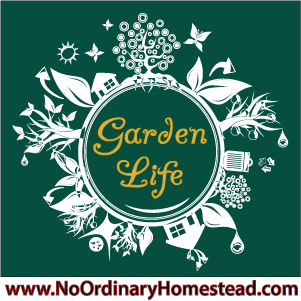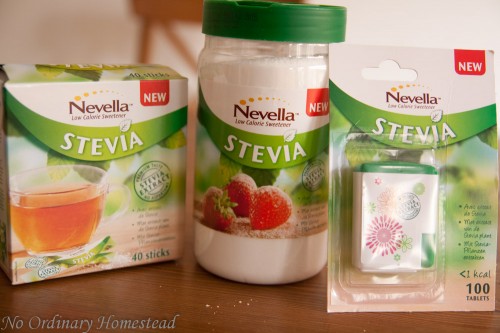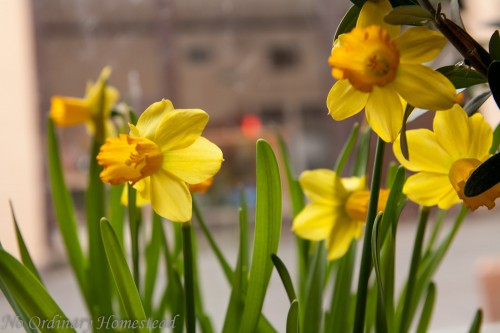 Back in 2007, we started our first adventure into growing stevia. We had heard about this naturally sweet plant and just had to try it out. We’re avid iced tea drinkers, and we like it sweet. So we end up going through a whole lot of sugar in a month. Although the iced tea still ends up being a bit healthier than a bunch of sodas, it still ends up being a bunch of empty calories we consume, not to mention what I put in the hot tea and coffee I drink during the day.
Back in 2007, we started our first adventure into growing stevia. We had heard about this naturally sweet plant and just had to try it out. We’re avid iced tea drinkers, and we like it sweet. So we end up going through a whole lot of sugar in a month. Although the iced tea still ends up being a bit healthier than a bunch of sodas, it still ends up being a bunch of empty calories we consume, not to mention what I put in the hot tea and coffee I drink during the day.
We started thinking about the options, and although sugar doesn’t seem to be horribly complicated to make from sugar beets (which they grow all over Germany), it’s a whole lot easier to just grow and dry plant leaves than it is to cook down sugar. And sugar cane is definitely not an option in the temperate climate of Germany. So stevia seemed like the idea solution.
But at the time we started thinking about this, stevia was not considered an acceptable sweetener (especially not to grow yourself) here in Germany, because apparently it was felt that enough testing hadn’t been done on its safety. Never mind the people that have been growing it and using it in their teas for the last 1500 years. So it became a bit of a challenge to find seeds or starter plants to get going.
What is stevia?
Stevia (Stevia rebaudiana), part of the sunflower family, is an herb native to subtropical and tropical regions from western North America to South America. The leaves of the plants are incredibly sweet…or can be if you get the right ones. In fact, you need a fraction of the amount of stevia compared to sugar. Which is good to know when you’re trying to grow your own.
| Granulated Sugar | Whole Stevia leaf powder | White Stevia Extract (powder) |
| 1 teaspoon | 1/8 teaspoon | Dust on spoon |
| 1 Tablespoon | 3/8 teaspoon | 1/2 pinch |
| 1/4 cup | 1 1/2 teaspoon | Pinch |
| 1/2 cup | 1 Tablespoon | 1/8 teaspoon |
| 1 cup | 2 Tablespoon | 1/4 teaspoon |
How to Grow Stevia
There are two ways to grow stevia: from seeds or from cuttings. We’ve tried it both ways, and I have to say that growing from seed is extremely unsuccessful. Supposedly only 20% of brown seeds sprout versus 80% of black ones. But there is also the risk of ending with plants that aren’t sweet, because stevioside levels (the sweet stuff) are not constant across all plants.
The best way to grow stevia is to get starter plants from a local nursery or online. We bought ours at exoga.de here in Germany and they’ve been great. In fact, the plants we bought last year are still growing happy and healthy in our kitchen right now and are still producing sweet leaves despite the fact that they’ve flowered.
Stevia will produce sweet leaves for about 2 years, but then the plants should be replaced with fresh cuttings. In the 3rd year, the sweetness of the plant usually tends to start tapering off. Stevia plants are not friends of frost and plantings outdoors should be done after the last frost, preferably with weather at least 50-60°F.
Harvesting Stevia
According to Stevia.net, you should harvest your leaves in autumn whenever possible, and basically just cut the top off the plant. So far, we haven’t done that (but probably will this year since our plants will be 2 years old) but have instead harvested leaves like you would harvest cutting lettuce. Once the leaves reach about 1-inch in width, I pluck them off. The leaves seems to be fully mature at that size and hold a lot of sweetness.
To use our leaves, we have been adding them to brew with the tea in a tea bag or filter. About two tablespoons of crushed stevia leaves is enough to lightly sweeten a gallon of iced tea. We’ve also created powder from a tiny bit of leaves and used it in drinks. Both were effective although I think stevia has a bit more of an aftertaste of sweet than the instant sweetness of sugar. You notice it more once you’re finished drinking instead of when it first hits your lips.
By the way, you can also now buy stevia extract sweeteners in the grocery store here in Germany. I found them at Rewe today. In the US, you will probably be able to find Truvia (Coca-Cola is behind that one) and Pepsi has there own as well.
Have you ever grown stevia? What’s an herb in your garden you couldn’t live without?
By the way, my narcissus are blooming. So fabulous! They’re like a ray of sunshine in my kitchen. 🙂
Want to join in the garden fun and link to your own blog or images online? You can share about anything related to gardening, old or new posts, from recipes to harvesting to grow reports to DIY projects or inspiration.
Here’s how this works:
PLEASE READ THESE GUIDELINES, especially if you have never linked up before!
|
That’s it! Share your garden with us by linking up below!






I am trying stevia this year but so far have had no luck sprouting my seeds. I have a few left in the packet and am going to give them some extra tlc, but if that doesn’t work I will be looking for a plant. We use liquid stevia in our tea and coffee every day so being able to grow it would be great!!
We never had any luck getting the seeds to sprout either. Perhaps there is some trick to it, but from what I’ve read, it’s just difficult in general…and then you don’t know if they’ll end up being sweet enough to use or not. So we just get the cuttings that have been sprouted already and go from there. This year, I hope to learn to make the cuttings myself so we don’t have to wait so long to start them. The exotics nursery which sells them here in Germany usually doesn’t have them until about May.
The trick to making any cutting grow is using rooting hormone(buy or make your own) and picking fresh flexible cuttings. I did this with a cherry tree, rosemary, tomatoes, blueberries and a hazel nut tree. I cant wait to see if it will work on raspberries too!
Great report on growing stevia. Barb uses an instant tea,and I buy a sweetner with sucralose for 10oz is $4.98, which is pretty resonable.Stevia is more expensinve at Walmart,too.
How is your garden plans and fruit tree orchard doing ????? Sounds like you have a true “green thumb”……
Hello,
I love sweet tea, but not with sugar. I love the idea of using Stevia. I’ll have to try it.
BTW, I love your blog 🙂
Noelle
I just started growing stevia this year and can’t wait to replace it in my tea, instead of that sugar! I also wonder as in the summer, I’ve been making a healthier vegan ice cream, which is better than store-bought. I have a vita mixer and it comes up like the soft serve, only your own ingredients, I think I will try it with my stevia, instead of the cane sugar!
How are your stevia plants doing? Don’t miss out on trying to propogate them yourself from cuttings also so that you can prolong the life of your plants. We had ours for some time but they are so difficult to start from seed!